Adolf Hitler was born on April 20, 1889, in Braunau-am-Inn, Austria, near the Austro-German border. Adolf's father, Alois, worked as a customs officer on the border. His mother, Klara, had previously given birth to two other children by Alois, Gustav and Ida, but they both died in infancy. Adolf attended school from the age of six, and the family lived in various villages around the town of Linz, east of Braunau. By that time, Adolf had a younger brother, Edmund, but he lived only until the age of six. In 1896, Klara gave birth to Adolf's sister, Paula, who would outlive him.
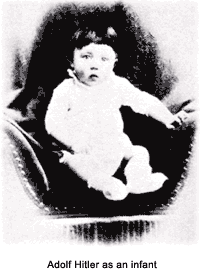 Hitler was a poor student and left school before graduation. He had an ambition to become an artist, and had gained an interest in politics and history. He applied twice unsuccessfully for admission to the Vienna Academy of Fine Arts. In 1909, after both parents had died, he moved to Vienna in the hope of earning a living. Living in homeless shelters and eating at charity soup kitchens, he declined to find regular employment, but took occasional menial jobs, and sold his paintings and advertising posters whenever he could to provide sustenance.
Hitler was a poor student and left school before graduation. He had an ambition to become an artist, and had gained an interest in politics and history. He applied twice unsuccessfully for admission to the Vienna Academy of Fine Arts. In 1909, after both parents had died, he moved to Vienna in the hope of earning a living. Living in homeless shelters and eating at charity soup kitchens, he declined to find regular employment, but took occasional menial jobs, and sold his paintings and advertising posters whenever he could to provide sustenance.
Munich and the Great War - 1913-1918
At Munich in 1914, near the beginning of World War I, Hitler volunteered for service in the German army and was accepted into the infantry. He fought bravely in the war, was promoted to corporal, and was decorated with the Iron Cross Second Class and First Class; the latter he wore until his dying day. On the day of the armistice announcement in 1918, Hitler was in a hospital recovering from temporary blindness caused by a British gas attack in the Ypres Salient. In December 1918 he was released from the hospital.
Early politics - 1918-1933
Between December 1918 and March 1919 Hitler, still a corporal in the German army, was posted to a German prisoner-of-war camp at Traunstein before returning to Munich. Shortly after his return he witnessed a governmental takeover bid by local Communists, who seized power before being ousted by the army. After Hitler gave evidence about the takeover attempt in an investigation, he was asked to become part of a local army organization that was responsible for persuading returning soldiers not to turn to Communism or Pacifism. During his training for that task, and his subsequent military duties, he was able to hone his oratory skills.
Private life
Hitler's first love was a much younger niece, Angelika ("Geli") Raubal, who died of a gun-shot wound to the chest at the age of 23. Subsequent intimates included Eva Braun, a secret mistress; Magda Goebbles, a loyal follower; and Winifred Wagner, daughter-in-law of the famous German composer.
The Nazi Party
As part of his duties, Hitler also was asked to spy on certain local political groups, and during a meeting of the German Workers' Party, became so incensed by one of the speeches that he uncorked a fierce harangue at the speaker. The party's founder, Anion Drexler, was so impressed by Hitler's tirade that he asked him to join their organization. Hitler, after some thought, finally agreed in September 1919. He was eventually given responsibility for publicity and propaganda. His oratory succeeded in attracting larger and larger audiences and party donations. The party's name was changed to the National Socialist German Workers Party (NAZI) on April 1, 1920.
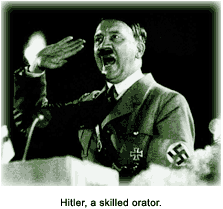 Hitler was discharged from the German army in February 1920. He continued to expand his influence in the party, and formed a private group of thugs that he used to quash disorder at party meetings, and later to break up rival parties' meetings. That group subsequently became the Sturmabteilung (SA) - Hitler's brown-shirted storm troopers. He also became the regular main speaker at party events and attracted large crowds at each meeting. Important Nazi Party members and Third Reich architechs, Heinrich Himmler, Hermann Goering and Rudolf Hess joined the party at this time.
Hitler was discharged from the German army in February 1920. He continued to expand his influence in the party, and formed a private group of thugs that he used to quash disorder at party meetings, and later to break up rival parties' meetings. That group subsequently became the Sturmabteilung (SA) - Hitler's brown-shirted storm troopers. He also became the regular main speaker at party events and attracted large crowds at each meeting. Important Nazi Party members and Third Reich architechs, Heinrich Himmler, Hermann Goering and Rudolf Hess joined the party at this time.
During the summer of 1920, Hitler chose the swastika, an ancient symbol historically used by many cultures, to be the Nazi Party emblem. By 1921 he had secured virtually total control of the Nazi Party. During that time Hitler also plotted to overthrow the German Weimar Republic by force. On November 8, 1923, he led an attempt to take over the local Bavarian government in Munich, in an action that became known as the "Beer Hall Putsch."
The coup was ended after a brief gunfight with Munich police. Himmler, Goering and Hess also participated in the putsch. Hitler was arrested and charged with treason. He successfully used the subsequent trial to gain publicity for himself and his ideas. Following his trial, he was sentenced to five years in Landsberg prison, but served only six months.
During his prison term, Hitler began to dictate his thoughts and philosophy to co-conspirator and cellmate Rudolf Hess, which became the book Mein Kampf (My Struggle). It became the blueprint for Hitler's political plans. In Mein Kampf, he contended that Germans should expand east, liquidate the Jews and turn the Slavs into slave labor. Hitler blamed the Jews for Germany's political and economic problems.
While in jail, Hitler realized he would have to take control of Germany by legal means, not through revolution. He increased the size of the Nazi Party, even though the government had banned it. Hitler's Brown Shirts terrorized political opponents on the streets, which discouraged political competition. During that period, Hitler also created the infamous Schutzstaffel (SS), which was initially intended to be Hitler's bodyguard under the leadership of Himmler.
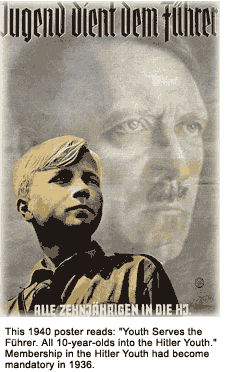 National politics - 1929-1934
National politics - 1929-1934
The collapse of the American Wall St. stock exchange in October 1929 lent fuel to a worldwide depression, which had hit Germany especially hard. All loans to Germany from foreign countries dried up, German industrial production slumped, and millions became unemployed. Unemployment in Germany had reached 43 percent by the end of 1932.
Those conditions were fertile ground for Hitler and his Nazi campaign. The Nazis became the second largest party in Germany. Hitler also began to win over the support of both the army and the big industrialists, the latter contributing substantially to Nazi Party finances. Both groups hoped Hitler would return Germany to its former pre-World War I status and glory. He assured top army leaders that the Nazis would reject the punitive Versailles Treaty and rearm Germany.
Hitler versus Hindenburg - 1932
In February 1932 Hitler decided to run against President Paul von Hindenburg. No one won a required majority on March 13, 1932, so a required second election gave Hindenburg 53 percent and Hitler 36.8 percent (one other candidate ran). Thus Hindenburg was re-elected and Hitler was forced to wait for another opportunity to win power.
Hitler's Third Reich began as he consolidated power. Through deft political manipulations by Hitler and his Nazi Party, President Hindenburg was forced to appoint Hitler as chancellor with Franz von Papen as vice-chancellor, on January 30, 1933.
After July 14, 1933, only the Nazi party was legal. All non-Nazi organizations were disbanded. Individual German states were stripped of autonomous powers and Nazi officials were installed as state governors. Hitler outlawed strikes and abolished independent labor unions. Publishers, universities, and writers were brought into line by intimidation and rough tactics. Democratic, socialist, and Jewish literature was placed on blacklists. Students and professors burned forbidden books in public squares. Modern art and architecture were prohibited.
German withdrawal from the League of Nations
A year later, however, Mussolini allied with Hitler to help fascists win in Spain during the Spanish Civil War (1936). Mussolini and Hitler used that conflict as a testing ground for their military forces: Italy's army and Germany's air force, the Luftwaffe.
The Night of the Long Knives - June 30, 1934
Hitler installed former SA leader, Ernst Röhm, as the new leader to reorganize and quiet the SA, whose numbers had grown to more than 60,000 members. The SA and its leadership would remain a problem for years for Hitler, culminating in a major crisis in the near future.
Hitler realized that the army and big business were suspicious of the SA (Brown Shirts). Hitler's SA was a purely political force, not a military one. Hitler needed the support of the German army if he was to be named as Hindenburg's successor. In May 1934, he struck a secret deal with the military chiefs to suppress the SA and increase support for the German military, in exchange for their support in his bid to succeed Hindenburg.
Pressure from Hindenburg and threats of a coup forced Hitler to order Himmler and Goering to eliminate the SA. On June 30, Hitler's elite personal guard, the SS, and the Gestapo arrested and shot - without a trial - about 1,000 SA leaders and other political enemies.
Having already ensured the Army's support, Hitler went a step further by compelling all of the armed forces to swear an oath of loyalty to him personally. A plebiscite was then held for the public to decide on whether they approved of the changes already made — 90 percent of voters gave their approval. Thus Hitler had become führer and reich chancellor, and the title of president was abolished.
"Nazification" - 1934-1937
The Nuremburg Race Laws of 1935 deprived Jews of all rights of citizenship. By 1938, 25 percent of German Jews had emigrated. Other victims of persecution included Slavs, gypsies, Jehovah's Witnesses, Communists, homosexuals, mentally handicapped persons, and political opponents. The Nazis indoctrinated German youth. Children were encouraged to turn in teachers, or even their parents, if they seemed disloyal to the reich.
The Road to World War II
To avoid a two-front war against France and Britain in the west and Russia in the east, Hitler signed the Nazi-Soviet Non-aggression Pact of August 1939. The world was shocked that two archenemies, Hitler and Stalin, would arrive at such an agreement.
Hitler sought assurances that the Soviet Union would not attack Germany if Germany invaded Poland. The public agreement was a non-aggression treaty; their private agreement was that Germany and the Soviet Union would invade Poland and split the country in half.
World War II was the main event of the 20th century. It was the largest, most destructive and costliest war in human history. Adolf Hitler was at the very core of the war. Hitler committed suicide in a bunker beneath the streets of Berlin in April 1945.
On May 8, 1945, Germany surrendered, ending the European part of the conflict. The results of the European war included approximately 57 million people dead; six million of them were Jews and others who perished in the genocidal Holocaust. Millions were left homeless and millions were refugees. Much of Europe lay in ruins.
It would require years to rebuild European economies. The American Marshall Plan committed more than $13 billion to rebuild Europe. The U.S. and Soviet Union emerged as the two dominant powers in the post-war world.
In the July 1932 elections, the Nazi Party won 13,745,000 votes, which gave them 230 out of the 608 seats in the Reichstag. Although the Nazis were the largest party, they were still short of a majority. Hitler, however, demanded of Hindenburg that he (Hitler) be made chancellor, but was offered only the position of vice-chancellor in a coalition government — which he refused. Hindenburg feared Hitler's potential for dictatorship. 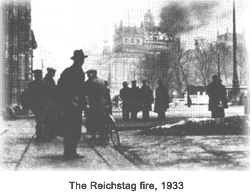 The burning of the Reichstag
The burning of the Reichstag
A February 1933 fire that burned the Reichstag building was blamed on a Communist. The incident was used by the Nazis to crack down on Communists in Germany. The "Enabling Act" of March 1933, passed by the Reichstag, gave Hitler legal dictatorial power for four years.
Hitler withdrew Germany from the League of Nations in 1933, while he secretly began to rearm the country. Italy's Fascist leader, Benito Mussolini, and others were concerned when Hitler withdrew from the Versailles Treaty. Understanding the danger, Italy, France and Britain protested strongly and agreed to use force against Germany to maintain the status quo.
Violence-prone and socialist-leaning SA members envisioned becoming a new German revolutionary army. By wreaking havoc in the streets despite Hitler's order to lie low, the SA became an embarrassment to Hitler. Through the SS, under its chief, Heinrich Himmler, Hitler put down a small SA revolt in Berlin. 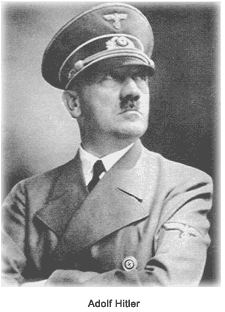 Hitler becomes Führer
Hitler becomes Führer
President Hindenburg died on August 2, 1934. Hitler had already agreed with the cabinet that, upon Hindenburg's death, the offices of president and chancellor would be combined. Hindenburg's last wish was that, upon his death, the monarchy be restored. Hitler managed to suppress that wish and did not publish the president's will.
Joseph Goebbels, minister of propaganda, effectively glorified Hitler and the Nazi state. The SS grew in influence dramatically as Hitler's private army. The SS joined the political police, the Gestapo, to expand its network of special courts and concentration camps. 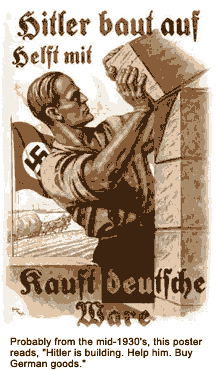 The German economic recovery contributed to Hitler's soaring popularity. He had delivered on his economic promise of "work and bread." Large public works programs started to pull Germany out of the depression. Programs included super highways (autobahn), office buildings, gigantic sports stadiums, and public housing. Government spending began to focus on the military with effective results. By 1938 the standard of living for the average employed worker increased moderately and business profits rose sharply.
The German economic recovery contributed to Hitler's soaring popularity. He had delivered on his economic promise of "work and bread." Large public works programs started to pull Germany out of the depression. Programs included super highways (autobahn), office buildings, gigantic sports stadiums, and public housing. Government spending began to focus on the military with effective results. By 1938 the standard of living for the average employed worker increased moderately and business profits rose sharply.
British Prime Minister Neville Chamberlain, swayed by pacifist feelings at home, adopted the policy of appeasement. Chamberlain returned to Britain from the 1938 Munich Conference a hero, proclaiming "peace in our time." The German invasion of Czechoslovakia during the spring of 1939 dismayed the double-crossed Chamberlain, who had stated that if Germany attacked Poland, there would be war in Europe.